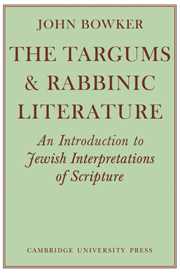Book contents
- Frontmatter
- Contents
- Preface
- Acknowledgements
- Note on the 1979 reprint
- Note on transliteration
- Note on bibliographical references
- List of abbreviations
- INTRODUCTION: THE BACKGROUND OF THE TARGUMS
- PS. JONATHAN ON SELECTED CHAPTERS OF GENESIS
- Appendices
- I The Biblical Antiquities of Philo: a translation of the passages related to Genesis
- II The Seven and Thirteen Rules of Interpretation
- III The Recognised variants in the Septuagint
- IV The Dotted Words in Genesis
- V The Tractates in the Mishnah
- VI Rabbinic Generations
- VII Cairo Geniza Fragments published in Kahle, Masoreten des Westerns, 11, part 2
- Bibliography
- Indexes
II - The Seven and Thirteen Rules of Interpretation
Published online by Cambridge University Press: 01 June 2011
- Frontmatter
- Contents
- Preface
- Acknowledgements
- Note on the 1979 reprint
- Note on transliteration
- Note on bibliographical references
- List of abbreviations
- INTRODUCTION: THE BACKGROUND OF THE TARGUMS
- PS. JONATHAN ON SELECTED CHAPTERS OF GENESIS
- Appendices
- I The Biblical Antiquities of Philo: a translation of the passages related to Genesis
- II The Seven and Thirteen Rules of Interpretation
- III The Recognised variants in the Septuagint
- IV The Dotted Words in Genesis
- V The Tractates in the Mishnah
- VI Rabbinic Generations
- VII Cairo Geniza Fragments published in Kahle, Masoreten des Westerns, 11, part 2
- Bibliography
- Indexes
Summary
Biblical interpretation gradually evolved its own rules and methods. Two sets of rules were particularly respected, the seven rules (or middoth) of Hillel, and the extension of them in the thirteen middoth of Ishmael.
The seven middoth of Hillel are listed in A.R.N. 37, the introduction to Sifra 3a, and T.San, vii. 11. The middoth are:
1. Qal waḥomer: what applies in a less important case will certainly apply in a more important case.
2. Gezerah shawah: verbal analogy from one verse to another; where the same words are applied to two separate cases it follows that the same considerations apply to both.
3. Binyan ab mikathub 'eḥad: building up a family from a single text; when the same phrase is found in a number of passages, then a consideration found in one of them applies to all of them.
4. Binyan ab mishene kethubim: building up a family from two texts; a principle is established by relating two texts together; the principle can then be applied to other passages.
5. Kelal upherat: the general and the particular; a general principle may be restricted by a particularisation of it in another verse; or conversely, a particular rule may be extended into a general principle.
6. Kayoẓe bo bemaqom 'aḥer: as is found in another place; a difficulty in one text may be solved by comparing it with another which has points of general (though not necessarily verbal) similarity.
- Type
- Chapter
- Information
- The Targums and Rabbinic LiteratureAn Introduction to Jewish Interpretations of Scripture, pp. 315 - 318Publisher: Cambridge University PressPrint publication year: 1969
- 1
- Cited by



